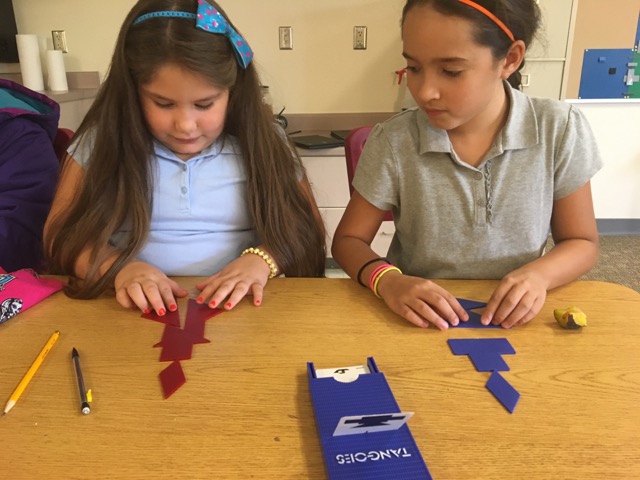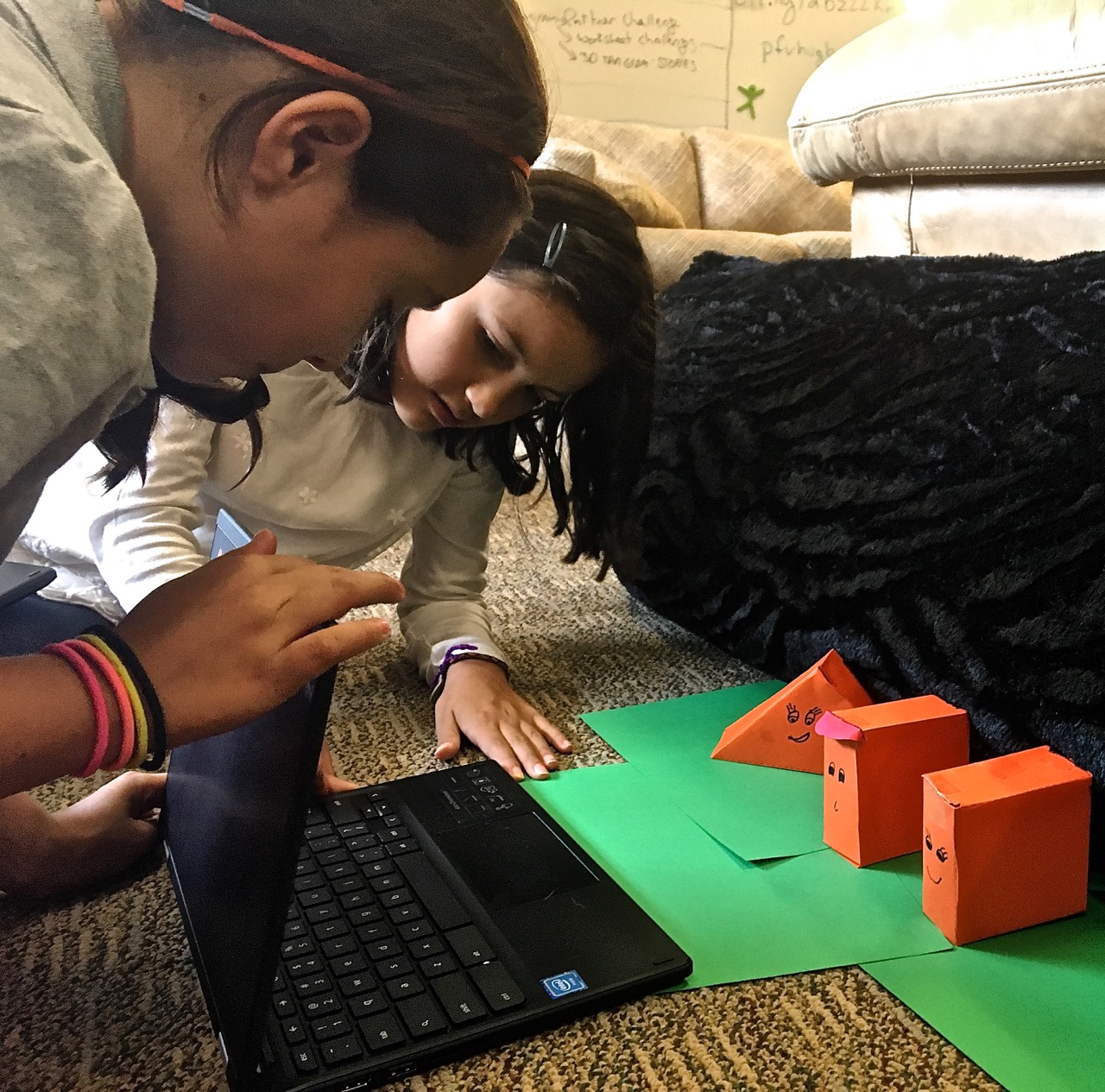Posts Tagged ‘21st century skills’
Universal Skills for Learners: Increasing School Relevancy
Kids are learning – but for way too many it occurs outside of the school environment rather than during school. Given today’s technologies, it makes sense and is exciting that learning occurs after schools hours, but for exciting, engaging, and profound learning not to occur during school hours is, simply put, a travesty.
I contend that school, especially in the latter part of the 20th century, had a high degree of irrelevancy but in today’s highly connected world, it is absurd, verging, in my perspective, as unethical practices. We are asking today’s students to spend so much of their school lives doing tasks that are unconnected to the the skills that need now and in their future lives.
. . . and the kids agree as studies have indicated.
Gallup has conducted more than 5 million surveys with students in grades five through 12 over the past several years. These students have come from every state and from a range of rural, suburban and urban school settings. Almost half of students who responded to the survey are engaged with school (47%), with approximately one-fourth “not engaged” (29%) and the remainder “actively disengaged” (24%). A closer look at the data by grade level reveals a disturbing trend. Engagement is strong at the end of elementary school, with nearly three-quarters of fifth-graders (74%) reporting high levels of engagement. But similar surveys have shown a gradual and steady decline in engagement from fifth grade through about 10th grade, with approximately half of students in middle school reporting high levels of engagement and about one-third of high school students reporting the same (School Engagement Is More Than Just Talk).
Just 54 percent of middle schoolers and 46 percent of high schoolers think their studies are relevant, according to new data from the nonprofit YouthTruth. Relevance was rated lowest on the survey of various measures of student engagement: if students take pride in their work, if they enjoy going to school, if their schoolwork is relevant, if they try to do their best, and if their teachers’ expectations help them with that goal (Only Half of Students Think What They’re Learning in School Is Relevant to the Real World, Survey Says).
Over five years ago, I wrote a post entitled Universal Skills All Learners Should Know How to Do in order to discuss those skills I believe are important for learners during this era. For this post, I revisited it. I revised it to now include financial literacy and civics.
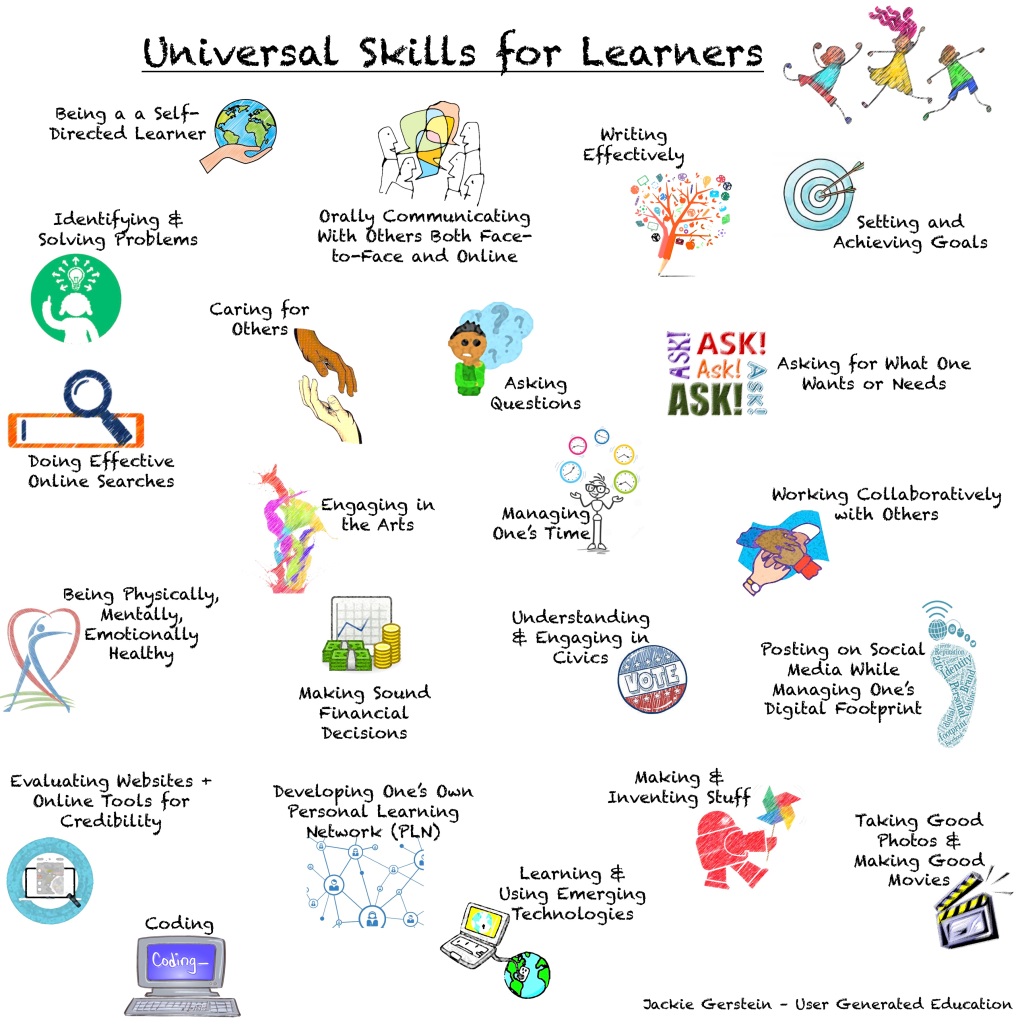
- How to be a self-directed learner – finding and using resources (both face-to-face and online) to learn and improve personal interests
- How to do effective online searches
- How to develop one’s own Personal Learning Network (PLN)
- How to post on social media while managing one’s digital footprint
- How to evaluate websites and online tools for credibility
- How to orally communicate with others both face-to-face and online (e.g., Facetime, Skype, Google Handouts)
- How to write effectively
- How to ask questions
- How to effectively ask for what one wants or needs
- How to set and achieve goals
- How to work collaboratively with others
- How to manage one’s own time
- How to be healthy – physically and emotionally
- How to care for others
- How to Enjoy and Engage in the Arts
- How to identify and solve problems
- How to make sound financial decisions
- How to understand and engage in civics
- How to take professional looking photos; make professional looking videos
- How to learn and use emerging technologies
- How to make and invent stuff
- How to code
I think most administrators and educators (and learners) would agree with the importance of most of the skills on this list to assist learners to be successful now and in their futures. Sadly, though, too few of these skills are directly and intentionally taught to learners: writing, speaking, and for more progressive schools, engaging in the arts and the computer science related skills. Is the current school system model really the best we can do?
The Benefits of the Copy Stage of Making
In Learning in the Making: How to Plan, Execute, and Assess Powerful Makerspace Lessons, I propose a model for the stages of making.

I believe that the heart of making is creating new and unique things. I also realize that in order for this type of making to occur, there needs to be some scaffolding so that maker learners can develop a foundation of knowledge and skills. This post focuses on the Copy Stage of this model.
- Copy – make something almost exactly as someone else has done.
In this age of information abundance, there really is an unlimited number of DIY resources, tutorials, Youtube videos, online instructors and instructions on making all kind of things. These resources provide a good beginning for acquiring some solid foundational skills and knowledge for learning how a make something one has never made before.
For a recent classroom activity, I wanted students to learn about and use Adafruit’s Circuit Playground. Some students made a Circuit Playground Dreidel (they learned about dreidels from an Orthodox Jewish student who was in my class and they loved it!) using the directions found at https://learn.adafruit.com/CPX-Mystery-Dreidel, and others made the Circuit Playground Scratch game with the directions found at https://learn.adafruit.com/adabot-operation-game/overview. I provided them with these directions and the expectation that the learners follow them pretty much on their own with me acting as an explainer and coach when they ran into difficulties. Here is a video of my learners enjoying their newly made dreidels.
The benefits of beginning maker activities with the Copy Stage includes:
- Basic Skill Development and Acquisition
- Foundational Skills for More Advanced and Creative Projects
- Following Step-By-Step Directions
- Positive Problem-Solving When Obstacles Occur
- Asking for Help From Peers
- A Sense of Accomplishment About Finishing a Project
- Enjoying the Use of Finished Products They Made

There has been a fair amount of criticism leveraged against “paint-by-numbers” types of STEM and maker kits. This criticism revolves around the stifling of the creativity of learners. I contend that learners need foundational skills so that they can be freed up to be creative. Think about learning how to cook or play an instrument. The basic and foundational skills need to be there in order for the makers to go in directions that are new and creative for them. For example, I spent several decades as a ceramic artist, making wheel thrown and altered pottery. I needed to know how to throw a decent bowl before I could go in that direction (and yes, my pottery in this image began as wheel thrown cylinders).

Natural Differentiation and Personalization Through Open Ended Learning Activities
This past summer I facilitated maker education classes for 5 to 10 year old kids. This school year I am a gifted teacher meeting with 2nd through 6 grades one day per week per group. I like mixed age groups and have no problem designing learning activities for them. I realized that the reason for this is that these activities are open ended permitting each student to naturally and instinctively to work at or slightly above his or her ability level. This actually is a definition of differentiation.
Many classrooms consist of students from different knowledge backgrounds, multiple cultures, both genders, and students with a range of disabilities or exceptionalities (Alavinia & Fardy, 2012). Differentiated instruction is defined as “a philosophy of teaching that is based on the premise that students learn best when their teachers accommodate the differences in their readiness levels, interest, and learning profiles” (Konstantinou-Katzi et al., 2012, p. 333). (in http://edutechwiki.unige.ch/en/Differentiated_learning)
One of results or consequences of providing such activities is an increase in learner engagement, excitement, and motivation. Open ended learning activities permit and encourage learners to bring their “selves” into the work. They become agents of their own learning.
Because of this freedom, they often shine as true selves come through. Learners often surprise both the educator and themselves with what they produce and create. It becomes passion-based learning. Not only do the activities become self-differentiated, they become personalized:
Personalization only comes when students have authentic choice over how to tackle a problem. A personalized environment gives students the freedom to follow a meaningful line of inquiry, while building the skills to connect, synthesize and analyze information into original productions. Diane Laufenberg in What Do We Really Mean When We Say ‘Personalized Learning’?
Personalized learning means that learning starts with the learner. Learning is tailored to the individual needs of each learner instead of by age or grade level. It is more than teaching to “one size fits all” or just moving to learner-centered learning and changing instruction. Personalized Learning takes a holistic view of the individual, skill levels, interests, strengths and challenges, and prior knowledge. The learner owns their learning. Barbara Bray in What is Personalized Learning?
The educator, in this environment, introduces the activities and then steps back to let the learners take over their own personal learning. The educator lets go of expectations what the final produce should be; should look like; should do. The educator becomes a provider of resources, feedback giver, and communications facilitator. S/he becomes a tour guide of learning possibilities. S/he shows learners the possibilities and then gets out of the way.
Creating the conditions for self-differentiation and personalization can occur with learning objectives that start with action verbs such: create, write, explore, invent, make, imagine, prepare, build, compose, construct, design, develop, formulate, originate.

Parting Shot: The following is an Animoto I created to show how many forms of making there are, but it also demonstrates what can happen when open ended projects are introduced into the learning environment.
A Perfect Storm for Maker Education
Originally published at http://blog.iat.com/2015/09/30/a-perfect-storm-for-maker-education/.
https://www.thinglink.com/scene/575147870160683008
Perfect Storm: an expression that describes an event where a rare combination of circumstances will aggravate a situation drastically. The term is also used to describe an actual phenomenon that happens to occur in such a confluence, resulting in an event of unusual magnitude.
Maker Movement:
The maker movement, as we know, is the umbrella term for independent inventors, designers and tinkerers, a convergence of computer hackers and traditional artisans. Makers tap into an American admiration for self-reliance and combine that with open-source learning, contemporary design and powerful personal technology like 3-D printers. The creations, born in cluttered local workshops and bedroom offices, stir the imaginations of consumers numbed by generic, mass-produced, made-in–China merchandise. (Why the Maker Movement Is Important to America’s Future)
A movement made up of hobbyists, tinkerers, crafters and innovators is getting ready to change what you thought you knew about the American economy. They’re teaching a new generation how to repair rather than replace, and if what they’re looking for is not available, to invent it. They call themselves “makers,” and they will figure out how to build whatever you can imagine. (The Maker Movement Is About the Economy, Stupid)
There currently exists the conditions for a perfect storm for maker education due to:
- The Do It Yourself (DIY) Movement
- Focus on STEM and STEAM Education
- Information Access and Information Abundance
- Affordable Maker Technologies
- Crowdsourcing and Participatory Culture
- Open Source Resources
The Do It Yourself (DIY) Movement
Do It Yourself, or DIY, is a term that is used by various communities of practice that focus on people creating things for themselves without the aid of a paid professional. embers of these subcultures strive to blur the lines between creator and consumer by constructing a social network that ties users and makers close together. The phrase Do It Yourself along with its acronym is also commonly used where a layman endeavors to complete a project without the physical aid of a paid professional. http://72.9.148.189/library/D.I.Y.
What this means for young people is that they are growing up in DIY cultures, where they have role models who engage in DIY and where they have 24-7 access to information and technological resources. For example, younger makers can turn to DIY, a safe online community for kids to discover and learn new skills. Older makers can use Make: DIY Projects for inspiration, ideas, and how-tos.
Focus on STEM and STEAM Education
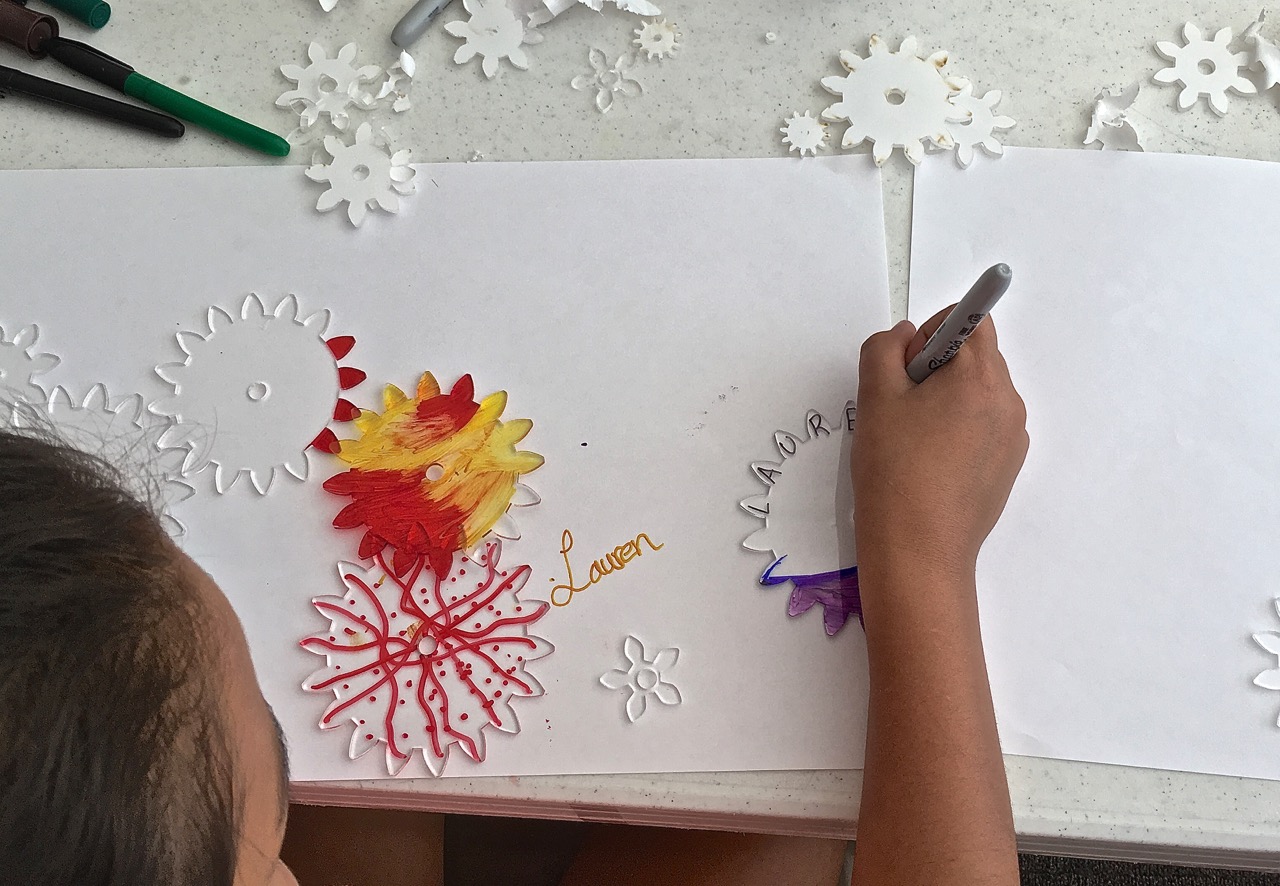
One of President Obama’s initiatives has been a call to action for making STEM (science, technology, engineering, mathematics) education a priority in the United States. He emphasized the need to broaden participation to those groups who typically do not engage in STEM initiatives:
President Obama knows that we simply cannot, as a Nation, expect to maintain our run of ingenuity and innovation—we cannot maintain that stream of new and different ideas—if we do not broaden participation in STEM to all Americans, including women and girls and minorities. (Educate to Innovate)
Some professionals and practitioners are expanding STEM education to include the arts which translates in STEAM education.
In this climate of economic uncertainty, America is once again turning to innovation as the way to ensure a prosperous future. Yet innovation remains tightly coupled with Science, Technology, Engineering and Math – the STEM subjects. Art + Design are poised to transform our economy in the 21st century just as science and technology did in the last century. (STEM to STEAM)
Maker education can be a gateway to STEM involvement by students who may not have had interest in the science, technology, engineering, and math disciplines in the past.
At a time when many people are asking how we can get more students interested in STEM fields, we are hearing from teachers who have found making to be a great way to get students excited and engaged in their classrooms. We are seeing making occurring in subject classes such as math or science — in classes specifically listed as maker classes — and in a variety of less formal settings such as clubs and study halls. Many of these projects incorporate a variety of STEM topics. Students working on designing and building furniture for their classroom use algebra and geometry to figure out the dimensions. E-textiles and soft circuitry, in which circuits are sewn using conductive thread or fabric, have shown to be an engaging way to teach electronics and programming, especially for young women. The possibilities for ways to incorporate making into the school day are endless, and it is exciting to see what teachers have been developing and sharing. (Engaging Students in the STEM Classroom Through “Making”)
Information Access and Abundance
We are living in one of the most exciting times in the history of humankind. Our world in now filled with information abundance, surplus, and access. The result is synergy whereby the human mind plus our current technologies far exceed the sum of these individual parts. We have technologies to access any type of information and to create products that match the pictures and voices in our minds; and we can use technology to get the assistance and feedback from folks around the globe. (Information Abundance and Its Implications for Education)
Anyone with access to the Internet has access to all kinds of information, resources, and tutorials. Young people are used to going online to find information and how-to tutorials via YouTube, Wikipedia, and their social networks. Young makers have taken advantage of this easy and free access information to make valuable contributions to our world. For example, Jack Andraka, who as a High School sophomore, discovered a test for pancreatic cancer through reading science research he found online. Katherine Wu, a ninth-grader, invented “the driver’s companion,” a device that could monitor drivers’ blinks and brain waves to see if they were in danger of falling asleep at the wheel. She studied neuroscience to find out how to identify signs of sleepiness, took an online course to learn how to create the computer code that would recognize those signs. (Local teens’ inventions impress scientists)
Affordable Maker Technologies

Accessibility of affordable maker technologies (e.g., 3D Printers, DIY computer devices) is due, in part to the democratization of these technologies.
When something is democratized it means that it is accessible to everyone. When used in the context of the maker movement, ‘democratization’ refers to the decreasing cost of the tools and technologies credited with spurring the movement. The cost of 3D printers, laser cutters, CNC machines, and 3D scanners has dramatically decreased over the past five years. (Democratized tools of production: New technologies spurring the maker movement)
Today, the availability of affordable constructive technology and the ability to share online has fueled the latest evolutionary spurt in this facet of human development. New tools that enable hands-on learning — 3D printers, robotics, microprocessors, wearable computers, e-textiles, “smart” materials and new programming languages — are giving individuals the power to invent. (The maker movement: A learning revolution)
Maker technologies such as Makey-Makey, littleBits, Arduinos, 3D Printers, and robotics kits provide opportunities for learners to experiment and invent for themselves. They are accessible and usable by a wide range of skill and age levels; and even though there is a cost attached to them, they are more accessible to those with less financial means than similar technologies had been in the past. There does, though, need to be a continued dialogue and proactive efforts to create a maker culture of accessibility.
If the rise of the maker movement and these new tools for democratized production are going to create opportunity, how do we ensure that all people truly have access and training? It is essential to understand and address the social structures and identity categories that are inherent in the maker movement before the tools of production that play such a prominent role are truly democratized. (Democratized tools of production: New technologies spurring the maker movement)
If one of the characteristics of the maker movement is democratization of related tools, software, and techniques, then efforts need to focus on the education institutions that serve children (school, libraries, museums, after-school programs) especially underrepresented and underserved children. We need to insure that there is little or no gap between those of means and those with little means when it comes to maker education. Dr. David A. Williams (SVP of Program, Training & Youth Development at Boys and Girls Club of America) has tackled this head-on at BGCA (Tackling the Digital Divide & Closing the Opportunity Gap in STEM Education) and so has Congressman Joe Kennedy in Boston (Do Politicians Really Care About STEM Education?).
Crowdsourcing and Participatory Culture
The maker movement and makerspaces are that they are driven by principles of crowdsourcing and participatory cultures. Makers, as a group, freely share their makes so others can replicate and/or improve upon them.
Many maker movement initiatives are rooted in the idea of a “Participatory Culture,” a term coined by American media scholar Henry Jenkins. Henry Jenkins recognizes the key elements of a participatory culture to include low barriers to expression and engagement, strong support for creating and sharing one’s creations with others, and some type of informal mentorship whereby what is known by the most experienced is passed along to novices. (Worlds of Making: Best Practices for Establishing a Makerspace for Your School By Laura Fleming)
And as Dale Dougherty (@dalepd), considered by many as the father of the maker movement, stated in the Maker Mindset:
The Maker Movement is spurred by [….] the increasing participation of all kinds of people in interconnected communities, defined by interests and skills online as well as hyper-local efforts to convene those who share common goals. (Dougherty, The Maker Mindset, 2013)
Massimo Banzi (@mbanzi), the inventor of the highly popular maker technology Arduino, noted how a participatory maker culture spurs creativity.
Whenever you design a tool that allows people to be creative, there are people who will start to be creative with the tool. Once we made that available, people are now responding and creating. So it’s not so much that we’ve become a world of people who do hardware hacking, but, I guess, a world where people are becoming more involved in the creation of products. (Arduino’s Massimo Banzi: How We Helped Make The Maker Movement)
Related to crowdsourcing is crowdfunding which, as it implies, is asking the public to fund some worthwhile causes. Crowdfunding sites like Donors Choose can help educators get maker materials for their classrooms, increasing the chances that underfunded classrooms can get the tools and materials related to the maker movement.
Open Source Resources
Open source software is software that can be freely used, changed, and shared (in modified or unmodified form) by anyone. Open source software is made by many people, and distributed under licenses that comply with the Open Source Definition.
Makers often share their “makes” so other can reproduce them and/or improve upon them. For example, Markerbot’s Thingiverse is probably one of the biggest online repositories of open source 3D designs. A quick perusal of the website shows designs everything from prosthetic devices to footwear to toys.
The sharing culture that marks the maker movement carries over into maker technology companies in that they often make their software and hardware open source. Popular educational maker hardware such as Arduinos and lillteBits are open source:
Open-source hardware shares much of the principles and approach of free and open-source software. In particular, we believe that people should be able to study our hardware to understand how it works, make changes to it, and share those changes. To facilitate this, we release all of the original design files (Eagle CAD) for the Arduino hardware. These files are licensed under a Creative Commons Attribution Share-Alike license, which allows for both personal and commercial derivative works, as long as they credit Arduino and release their designs under the same license. (Arduinos FAQ)
littleBits has the following to say about developing open source hardware:
Open Source Hardware means that we make the design files available for the circuit designs in our modules pursuant to the CERN Open Hardware License Version 1.2. It makes sense for us because littleBits products are a teaching tool: sharing our designs allows for the possibility of teaching how these circuit designs work down to a circuit level. (What does Open Source mean?)
The bottom line is that educators both in formal and informal settings would be foolish not to take advantage of this perfect storm of maker education resources, tools, and strategies that currently exist.
Maker Camp: Toy Making and Hacking
For the past two summers, I have gotten the marvelous opportunity to teach maker education camps to elementary level students, ages 5 to 12. Each week has a different theme and each theme meets for the five weekdays from 9:00 to 12:00 with a half hour break. Our first week’s theme was on Toy Making and Hacking. Here are the webpages of resources I aggregated on these maker activities:
- DIY Science Toys – http://www.makereducation.com/diy-science-toys.html
- Toy Take Apart – http://www.makereducation.com/toy-take-apart.html
Below is a list of activities completed with the students along with descriptions and my reflections on the degree of success with these activities.
- Stomp Rockets
- Gami-Bots
- Colorful Gears
- Candy Gobbler
- Small Toy Take Apart
- Portable Gaming Devices Take Apart – Invent a New Game
Stomp Rockets


Materials:
- 1/2″ PVC Pipe (cut into 36″, 3 x 12″; 6″ segments – one set per participant.
- 1/2″ right angle joints – 3 per participant
- 1/2″ cross joints – 1 per participant
- magazines
- cotton balls
- pennies
- transparent tape
Procedures:
I made some minor modifications of plans presented at http://www.instructables.com/id/Paper-Stomp-Rockets-Easy-and-Fun/. For the camp, I had each camper make his or her own launcher. One or two launchers, though, would have been fine for this activity.
Reflection:
I was excited to begin our week together with this activity as it is high impact. I did stomp rockets before with this age group a few years back. What I didn’t anticipate was the difficulty the campers would have making their rockets. They had trouble rolling the magazine pages around the PVC pipe and taping everything together. I was actually a little baffled that they couldn’t do these not too difficult hands-on tasks. As such, their rockets didn’t perform as they should off and several campers were very disappointed.
I would like to do this activity again in the future. If so, I would (1) do it later in the camp week, and (2) concentrate more on making the rockets insuring that the kids build fairly functional rockets.
Gami-Bots


Materials:
- business cards
- scissors
- cell phone motors
- double stick tape
- transparent tape
Procedures:
The following plans were developed by Howtoons and can be found at http://www.howtoons.com/?page_id=3475

Reflection:
The maker campers really loved this activity. They all were successful is getting their Gami-bots to move. They even invented a game using the floor tiles whereby they placed all of their Gami-bots inside the tile and the last Gami-bot left inside the boundaries of that tile won. I had one of the campers’ mother ask if I could do maker activities for her son’s birthday. This was one of the projects she requested.
Colorful Gears


Materials:
- laser cut gears of assorted sizes
- magnets (6x6mm 1/4″X1/4″)
- magnetic boards
- permanent markers
Procedures:
I had seen something similar at an EdTech conference but out of wood. Instead of wood, I laser cut the gears out of acrylic. I used http://geargenerator.com/ to get the size of interlocking gears I desired and sized the middle holes to be a little bigger than 1/4″ to fit the magnets. This site produced files I used with the laser cutter at a local makerspace. I had the campers color their gears with permanent markers and then attach them to magnetic boards using the magnets as pivot points.
Reflections:
I was really excited about this activity. I think gears are lots of fun. I also thought that by having the campers color and create their own patterns would increase interest. I was wrong. They did the activity, seemed to like it okay, but were ready to move on once they did a single gear connection. I attempted introducing group collaborative creations as can be seen in the right photo above. A few were interested but not with overwhelming enthusiasm. I probably won’t be doing this activity again.
Mad Monster Candy Snatch Game


Materials:
- 2 liter bottle
- Tweezers
- Doorstop spring
- Aluminum foil
- copper tape
- 5 MM LED lights
- Batteries and terminal connections
- Double sided alligator cables
- Candy or prizes for the gradding
Procedures:
I modified the plans presented at http://makezine.com/projects/make-41-tinkering-toys/monster-candy-game/.

I simplified this design by creating parallel circuits to have the LED eyes light up if the Tweezers touch the wired mouth (similar to a DIY operation game – see http://www.makereducation.com/operation-game.html).
Reflections:
I knew this would be a difficult one and warned the campers of the high difficulty level. Most kids had some problems getting their gobble monster to work so I asked them to reflect on their learning experiences:
Last summer I asked the campers to make Operation Games. All were successful so for future camps, I’ll stick with the Operation Game.
Toy Take Apart and Create Something New

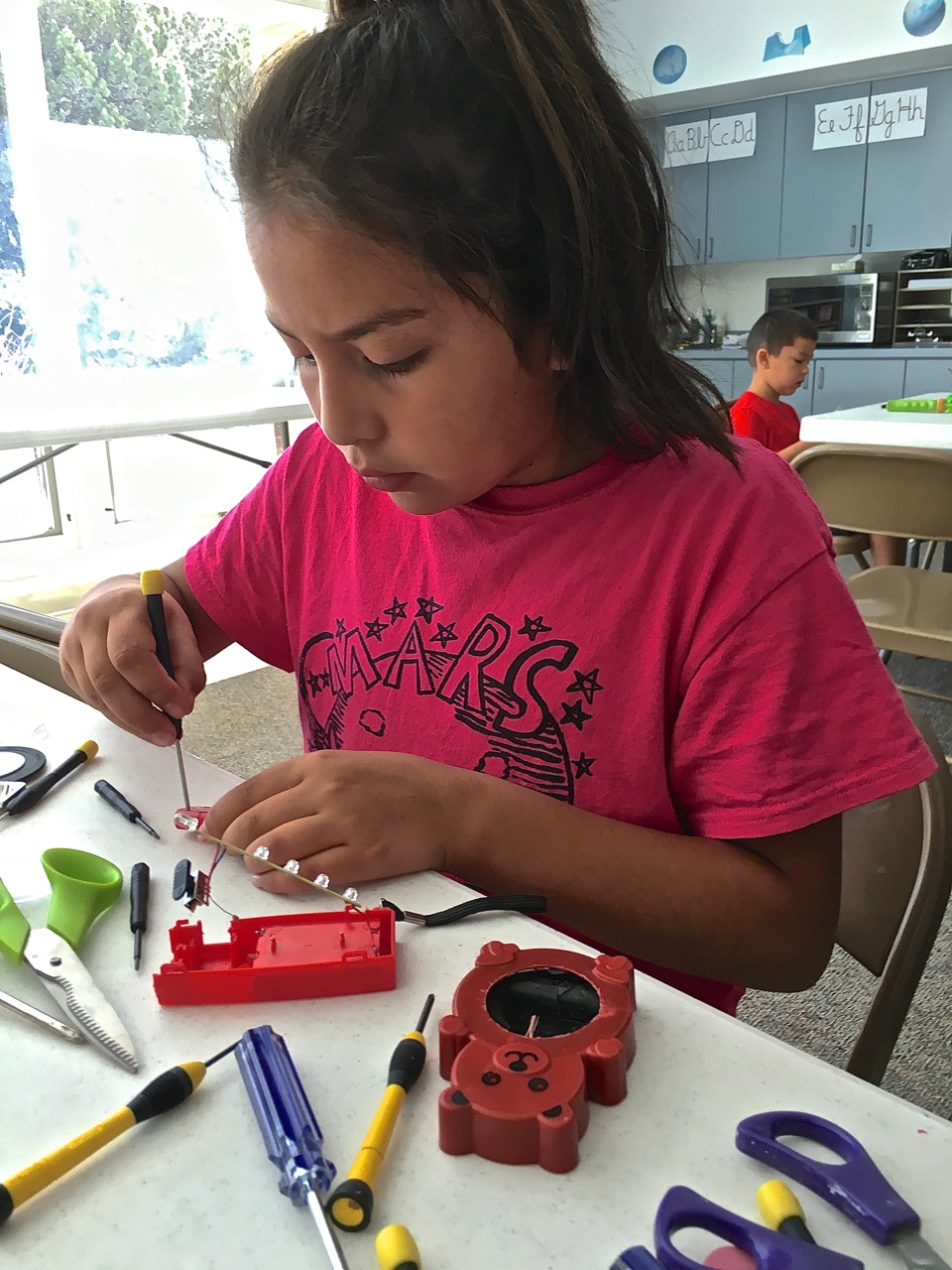
- Small Toys-Electronics (bought from the Dollar Store)
- Handheld Games (bought a box from ebay and from local thrift store)
- Screwdrivers-hammers to take the toys apart
- Hot Glue and/or Solder to create new toys
Procedures:
See http://www.makereducation.com/toy-take-apart.html for information and resources about doing toy take aparts and hacking. My biggest rule for doing toy take aparts is that the kids need to create something new – a new invention, a new toy, something to make the world better. It isn’t just about taking things apart, it is about using those parts to make something different . . . new . . . better. Below are a few of the maker education campers explaining their hacks:
Reflections:
Toy Take Aparts are always successful. The kids sometimes get frustrated trying to take the toys apart but with a hammer (used by me), we can break apart the most stubborn of toys. I love seeing the kids reactions as they find out what’s inside of an electronic toy and seeing them use their creativity to make something new out of the parts. This is a keeper!
Maker Education Card Game
I like and have always used games in my classrooms. One of my current educational interests is maker education. As such, I have begun creating games for maker education – see my first one, a board game, at Reflecting on the Making Process. The game I am presenting here is a card game that ends with the makers making something based on selected cards. Each maker picks a card from each of the three categories:
- The Thing or Process
- The Product
- The Population.
For example, a maker may choose, Create a Blueprint from The Thing or Process category; a New Toy from the Product category; and Adults from the population category meaning the maker would create a blueprint for a new toy for adults. The educator and makers can choose whether it is a “blind” pick or one in which the makers see their options. (Note – I would love to increase options in all categories. If you have additional card ideas, please leave them in the comments section).
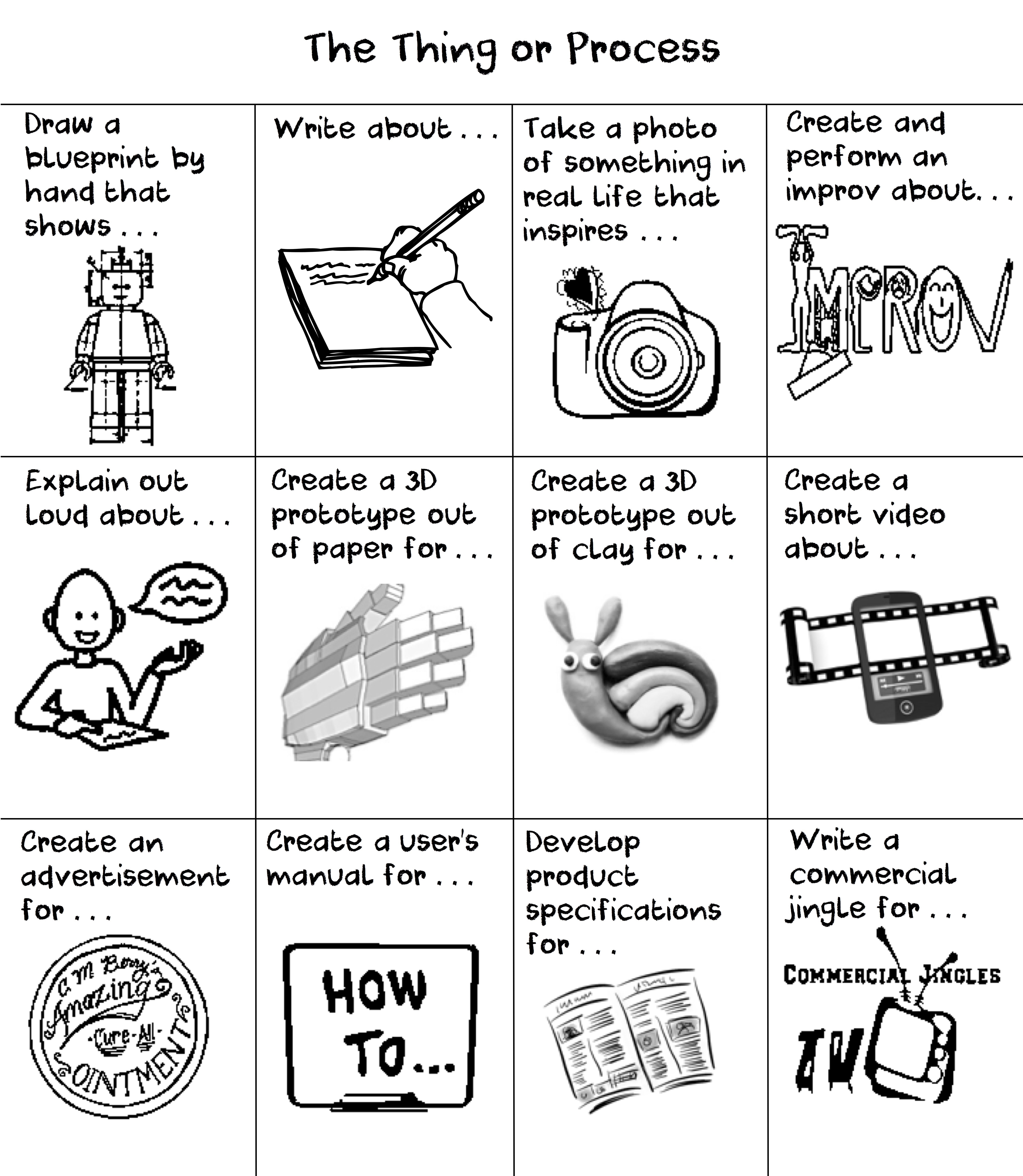


Cross Curricular Maker Education Activity That Addresses Common Core Standards
My primary job is that of educating pre and in-service teachers with a bit of teaching elementary students along the way. I often say that there is not enough time during the school day and the school year to teach isolated and singular content area topics. I stress designing and teaching cross-curricular thematic units. Not only will the learners then get to experience multi-layered instruction, they will also experience more authentic learning experiences. Real life learning doesn’t segment itself into isolated content areas.
What follows is a specific lesson for upper elementary and middle school students. It combines geometry concepts with a language arts activity while addressing several common core standards.
- Grade Level: Grades 6 through 8
- Title: Geometry Meets Maker Education
- Brief Description: Learners create a robot using geometric shapes and LEDs. They then compose a comic strip using Storyboard That which describes the geometric properties of their robot.
- Common Core State Standards Addressed
- Math: Solve real-world and mathematical problems involving area, surface area, and volume.
- CCSS.Math.Content.6.G.A.4 Represent three-dimensional figures using nets made up of rectangles and triangles, and use the nets to find the surface area of these figures. Apply these techniques in the context of solving real-world and mathematical problems.
- CCSS.Math.Content.7.G.B.6 Solve real-world and mathematical problems involving area, volume and surface area of two- and three-dimensional objects composed of triangles, quadrilaterals, polygons, cubes, and right prisms.
- English Language Arts
- ELA: CCSS.ELA-Literacy.WHST.6-8.2 Write informative/explanatory texts, including the narration of historical events, scientific procedures/ experiments, or technical processes.
- CCSS.ELA-Literacy.WHST.6-8.2.d Use precise language and domain-specific vocabulary to inform about or explain the topic.
- Math: Solve real-world and mathematical problems involving area, surface area, and volume.
- ISTE’s NETS-S standards addressed
- Creativity and innovation: Students demonstrate creative thinking, construct knowledge, and develop innovative products and processes using technology.
- Apply existing knowledge to generate new ideas, products, or processes
- Create original works as a means of personal or group expression
- Use models and simulations to explore complex systems and issues
- Communication and collaboration: Students use digital media and environments to communicate and work collaboratively, including at a distance, to support individual learning and contribute to the learning of others.
- Communicate information and ideas effectively to multiple audiences using a variety of media and formats.
- Creativity and innovation: Students demonstrate creative thinking, construct knowledge, and develop innovative products and processes using technology.
- Materials
- Various geometric 3D styrofoam shapes (http://www.smoothfoam.com/category/Smoothfoam.html)
- LED Lights (http://lighthouseleds.com/)
- Coin Batteries
- Miscellaneous art supplies
- Glue guns and electric tape
- Measuring tapes t
- Computer – one per participant
- The Learning Activities
- Learners are offered a variety of styrofoam shapes, LED lights/coin batteries, miscellaneous art supplies and glue guns.
- Learners are given the task of building a robot composed of geometric shapes.
 Learners are asked to determine the surface area of their robots using the tape measures to get dimensions of individual pieces. They can use the LearnZillion tutorial to assist them – https://learnzillion.com/resources/72676-use-nets-to-represent-three-dimensional-figures-and-find-surface-area-6-g-a-4.
Learners are asked to determine the surface area of their robots using the tape measures to get dimensions of individual pieces. They can use the LearnZillion tutorial to assist them – https://learnzillion.com/resources/72676-use-nets-to-represent-three-dimensional-figures-and-find-surface-area-6-g-a-4.- Learners share their results, both their constructed robots and their surface area results, with peers. Peers give feedback.
- Learners are then told that they are to explain the properties and story of their robots through a digital story using Storyboard That. Their stories need to be at least four panels and contain both images and test in each of the panels. These are shared with peers.

- Assessment
- Learning is assessed through learner self-reflections using the Google form: https://docs.google.com/forms/d/1H0Q3rTERUuylntFbaa1tZrxVAwTSYIIReo99ow7p8uc/viewform?usp=send_form
- Reflection
Having learners engage in hands-on activities, both with the art items and with the technologies, permits educators to directly observe the performances of their students. Because these activities are somewhat self-directed, educators can actually view the learning activities as formative assessments and intervene when individual learners are having problems. This increases the chances that mastery by all learners are achieved.












